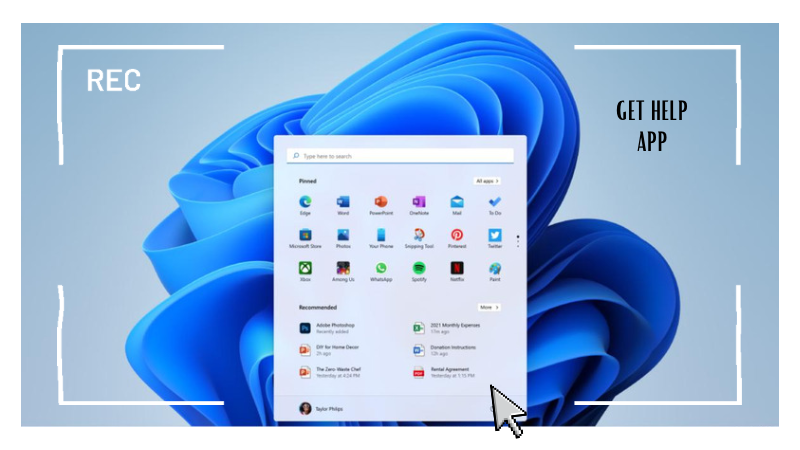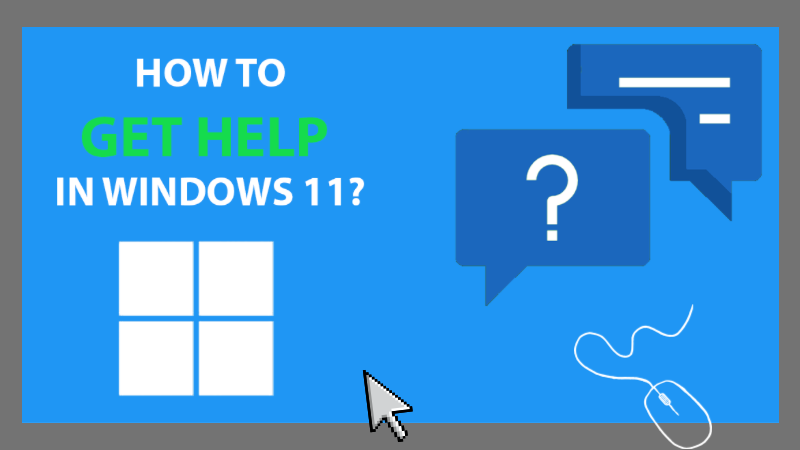Introduction:
Windows 11, the tech-savvy companion that keeps your digital life running smoothly, sometimes has its fair share of hiccups. We’ve all been there, trying to meet deadlines or binge-watch our favorite shows, only to be thwarted by mysterious audio issues, network glitches, or printer malfunctions. Fret not, dear reader, for there’s a hero in disguise, ready to rescue us from the clutches of technological chaos. Enter the Microsoft Get Help app, the friendly therapist for your Windows woes.
Now, you might be wondering, “Wait, did my computer just suggest therapy?” Well, not exactly, but it does offer a range of troubleshooters that can help diagnose and fix those pesky problems that pop up when we least expect them. Think of the Get Help app as your computer’s personal therapist, armed with knowledge and solutions to bring harmony back to your digital existence. So, grab your virtual notepads and prepare to embark on a troubleshooting adventure like no other.
But first, let’s get acquainted with this charming app. The Get Help app is like a hidden treasure chest, waiting to be discovered in the vast realms of Windows 11. It’s a place where you can seek solace, find answers, and put an end to the technological tantrums that make you question the very fabric of your digital existence. With a few clicks and a sprinkle of digital magic, you’ll unlock a world of troubleshooters that can diagnose and mend a wide array of issues.
So, my technologically adventurous friend, whether you’re a novice or a seasoned Windows explorer, join me as we unravel the secrets of the Microsoft Get Help app. Together, we’ll navigate the troubleshooters, decode their mysteries, and bid farewell to the quirks that disrupt our digital bliss. Are you ready to embark on this enlightening journey? Great! Let’s dive into the world of troubleshooting and show those Windows woes who’s boss!
Note: Remember to keep your sense of humor intact throughout the troubleshooting process. After all, laughter is the best debugging tool!
Understanding the Microsoft Get Help App:
With the retirement of the Microsoft Support Diagnostic Tool (MSDT) troubleshooters on the horizon, the Microsoft Get Help app emerges as the go-to solution for resolving Windows issues. Accessing the Get Help app is easy; simply search for it in the Start Menu or navigate through the Settings app by selecting System > Troubleshoot > Other troubleshooters.

Using Different Troubleshooters in the Microsoft Get Help App:
Now that we have acquainted ourselves with the Get Help app, let’s delve into the step-by-step process of using different troubleshooters available within it:
Printer Troubleshooter:
Dealing with printer-related problems? The Get Help app’s Printer Troubleshooter is here to lend a hand. Search for “Run Printer Troubleshooter” within the app and grant consent for the diagnostic process. The troubleshooter will scan your computer and suggest fixes for your printer issues. Follow the onscreen instructions to apply the recommended solutions successfully.
Audio Troubleshooter:
Tired of audio issues on your Windows computer? The audio troubleshooter in the Get Help app can come to your rescue. Launch the app, type “Audio Troubleshooter” in the search bar, and hit Enter. Give consent to run the automatic diagnostic and let the troubleshooter scan your computer for audio problems. It may even play a test sound to check your audio device. Follow the onscreen instructions to complete the troubleshooting process, and if needed, provide feedback or talk to an agent.
Bluetooth Troubleshooter:
Trouble connecting Bluetooth devices or accessing Bluetooth functionality? The Bluetooth Troubleshooter in the Get Help app is designed to assist you. Launch the app, search for “Run Bluetooth Troubleshooter,” and allow it to diagnose and propose fixes for the Bluetooth problem. If the suggested solutions don’t resolve the issue, the Contact Support button can be used to seek further assistance from the Microsoft support team.
Network and Internet Troubleshooter:
Connectivity woes can be frustrating, but the Get Help app’s Network and Internet Troubleshooter can help you overcome them. Open the app, search for “Network and Internet Troubleshooter,” and select the launch option. The troubleshooter will scan your system for network issues and propose fixes to resolve them. If the issue is successfully resolved, exit the network testing; otherwise, consider reaching out to the Microsoft support team.
Video Playback Troubleshooter:
From buffering to sudden freezes, video playback issues can be frustrating. Fortunately, the Video Playback Troubleshooter in the Get Help app can help you address these problems. Launch the app and search for the Video Playback Troubleshooter to initiate the troubleshooting process.
Windows Update Troubleshooter:
Windows update issues can be a roadblock to enjoying the latest features. Thankfully, the Windows Update Troubleshooter in the Get Help app can help you overcome these hurdles. Type “Run Windows Update Troubleshooter” in the app’s search bar and allow the troubleshooter to scan your computer. Apply the suggested fixes to resolve any update-related problems that are encountered.
Background Intelligent Transfer Service (BITS) Troubleshooter:
Background Intelligent Transfer Service (BITS) ensures smooth file transfers in the background. However, if it malfunctions, it can impact the download process for various applications. Use the Get Help app’s BITS troubleshooter to address BITS-related issues. Search for “Run the Background Intelligent Transfer Service (BITS) Troubleshooter” in the app, follow the onscreen instructions, and resolve the problem effectively.
Camera Troubleshooter:
Is your camera misbehaving? The camera troubleshooter in the Get Help app can help you troubleshoot the problem. Simply search for “Camera Troubleshooter” within the app and apply the recommended solution provided by the troubleshooter.
Program Compatibility Troubleshooter:
When you encounter compatibility issues with certain apps on your Windows version, the Program Compatibility Troubleshooter comes to the rescue. Launch it by searching for “Run Program Compatibility Troubleshooter” in the search bar, and follow the prompts. You’ll be redirected to an article that provides instructions on making programs compatible with your Windows version.
Windows Media Player Troubleshooter:
If you’re encountering issues with the Windows Media Player, the Get Help app’s Windows Media Player Troubleshooter is here to help. Search for it within the app and grant permission for the troubleshooter to run on your device. Apply the suggested solutions to resolve the problem and get back to enjoying your media.
Conclusion:
With the retirement of the MSDT troubleshooters, the Microsoft Get Help app has become an essential tool for resolving Windows issues. By leveraging its various troubleshooters, such as the Audio Troubleshooter, Network and Internet Troubleshooter, Printer Troubleshooter, and more, you can troubleshoot and resolve a wide range of issues efficiently. The Get Help app is your gateway to a smoother Windows experience, enabling you to address common problems with ease. So, the next time you encounter an issue, remember to turn to the Get Help app for assistance.
Q: How can I access the Microsoft Get Help app in Windows 11?
You can access the Microsoft Get Help app by searching for it in the Start Menu or by opening the Settings app and navigating to System > Troubleshoot > Other troubleshooters.
Can I still use the legacy inbox troubleshooters (MSDT) in Windows 11?
Microsoft plans to retire the MSDT troubleshooters in upcoming Windows updates and eliminate the MSDT platform by 2025. As a result, many MSDT troubleshooters will be redirected to the Microsoft Get Help app.
What should I do if a troubleshooter in the Get Help app fails to resolve my issue?
If a troubleshooter is unable to resolve the issue, the Get Help app provides options to provide feedback or talk to an agent. You can choose either of these options for further assistance.
Can I contact the Microsoft support team directly from the Get Help app?
Yes, for certain troubleshooters, such as the Network and Internet Troubleshooter or Bluetooth Troubleshooter, you have the option to contact the Microsoft support team directly from the app if the troubleshooter is unable to resolve the issue.
Are there any additional resources available in the Get Help app to assist with troubleshooting?
Yes, the Get Help app also provides links to articles that offer further guidance and solutions for troubleshooting specific problems. These articles can provide valuable insights and additional troubleshooting steps.
Can I run multiple troubleshooters simultaneously in the Get Help app?
No, you can only run one troubleshooter at a time in the Get Help app. It is recommended to focus on one issue at a time to ensure effective troubleshooting.
Is the Get Help app available only for Windows 11, or can I use it on earlier versions of Windows?
The Get Help app is primarily designed for Windows 11. While earlier versions of Windows may have their own troubleshooters and support tools, the specific functionality and availability of the Get Help app may vary.
Are there any known limitations or compatibility issues with the Get Help app?
The Get Help app is designed to be compatible with Windows 11 and aims to address common Windows issues. However, it’s always recommended to keep your operating system up to date to ensure the best compatibility and performance.
Remember, if you encounter any specific issues or have further questions, it’s always a good idea to consult official Microsoft documentation or reach out to their support channels for the most accurate and up-to-date information.

